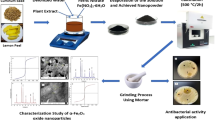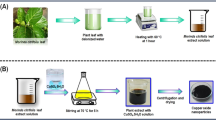Abstract
Objectives
Citrullus colocynth (CTC) is a wild medicinal plant with proven antimicrobial activity. The aim of this study is to investigate the use of its aqueous extract in producing magnetic iron oxide nanoparticles (MNPs) with improved antimicrobial activity. The cold and hot aqueous extract of seed and pulp parts of CTC, respectively, were used to produce MNPs. The particles were characterized by transmission electron microscope, energy dispersion x-ray, FTIR and their surface charge were measured. The antimicrobial activity of the produced particles was assessed against two Gram positive (Bacillus subtillis and Staphylococcus aureus) and two Gram negative (Escherichia coli and Pseudomonas aeruginosa) bacteria and well as against Candida albicans.
Results
MNPs synthesized using cold seed extract (S-MNP) and pulp extract (P-MNP) were spherical in shape. The size distribution was more uniform in the S-MNP (6–15 nm) compared to the P-MNP (12–45 nm). Both particles showed comparable anti-microbial potential against the tested microorganisms. At a concentration range of 0.48–1000 μg/mL, S-MNP inhibited bacterial growth by 16.0–99.0% and 10.0–91.0%; while P-MNP inhibition was 11.0–100.0% and 11.0–99.0% for Gram positive and negative bacteria; respectively. Candida albicans was the least affected microorganism with maximum inhibition of 63–88% after treatment with S-MNP and P-MNP (1 mg/mL), respectively.
Conclusions
The aqueous extract of CTC can be used for synthesis of MNPs with antimicrobial activity. The described procedures are simple and can be modified for large scale green synthesis of MNPs.





Similar content being viewed by others
References
Arakha M et al (2015) Antimicrobial activity of iron oxide nanoparticle upon modulation of nanoparticle-bacteria interface. Sci Rep 5:14813
Azizi S, Mohamad R, Mahdavi Shahri M (2017) Green microwave-assisted combustion synthesis of zinc oxide nanoparticles with Citrullus colocynthis (L.) Schrad: characterization and biomedical applications. Molecules 22:301
Barghamdi B, Ghorat F, Asadollahi K, Sayehmiri K, Peyghambari R, Abangah G (2016) Therapeutic effects of Citrullus colocynthis fruit in patients with type II diabetes: a clinical trial study. J Pharm Bioallied Sci 8:130–134. https://doi.org/10.4103/0975-7406.171702
Benariba N, Djaziri R, Bellakhdar W, Belkacem N, Kadiata M, Malaisse WJ, Sener A (2013) Phytochemical screening and free radical scavenging activity of Citrullus colocynthis seeds extracts. Asian Pac J Trop Biomed 3:35–40. https://doi.org/10.1016/S2221-1691(13)60020-9
Bini RA, Marques RFC, Santos FJ, Chaker JA, Jafelicci M Jr (2012) Synthesis and functionalization of magnetite nanoparticles with different amino-functional alkoxysilanes. J Magn Magn Mater 324:534–539
Blanc D et al (2016) Hand soap contamination by Pseudomonas aeruginosa in a tertiary care hospital: no evidence of impact on patients. J Hosp Infect 93:63–67
Brondon J, Willis ZI, Weber DJ, Kasow KA (2018) Staphylococcus Aureus bloodstream infection due to contaminated hematopoietic stem cell graft. Biol Blood Marrow Transplant 24:S393
Charron D, Bédard E, Lalancette C, Laferrière C, Prévost M (2015) Impact of electronic faucets and water quality on the occurrence of Pseudomonas aeruginosa in water: a multi-hospital study infection control & hospital. Epidemiology 36:311–319
Chekroun E, Benariba N, Adida H, Bechiri A, Azzi R, Djaziri R (2015) Antioxidant activity and phytochemical screening of two Cucurbitaceae: Citrullus colocynthis fruits and Bryonia dioica roots. Asian Pac J Trop Dis 5:632–637. https://doi.org/10.1016/S2222-1808(15)60903-3
Daoudi A, Aarab L, Abdel-Sattar E (2013) Screening of immunomodulatory activity of total and protein extracts of some Moroccan medicinal plants. Toxicol Ind Health 29:245–253
El Zowalaty ME, Al Ali SHH, Husseiny MI, Geilich BM, Webster TJ, Hussein MZ (2015) The ability of streptomycin-loaded chitosan-coated magnetic nanocomposites to possess antimicrobial and antituberculosis activities. Int J Nanomed 10:3269
Elhamifar D, Ramazani Z, Norouzi M, Mirbagheri R (2018) Magnetic iron oxide/phenylsulfonic acid: a novel, efficient and recoverable nanocatalyst for green synthesis of tetrahydrobenzo[b]pyrans under ultrasonic conditions. J Colloid Interface Sci 511:392–401. https://doi.org/10.1016/j.jcis.2017.10.013
Hajjar D, Kremb S, Sioud S, Emwas A-H, Voolstra CR, Ravasi T (2017) Anti-cancer agents in Saudi Arabian herbals revealed by automated high-content imaging. PLoS ONE 12:e0177316
Hussein-Al-Ali SH, El Zowalaty ME, Hussein MZ, Geilich BM, Webster TJ (2014) Synthesis, characterization, and antimicrobial activity of an ampicillin-conjugated magnetic nanoantibiotic for medical applications. Int J Nanomed 9:3801–3814. https://doi.org/10.2147/IJN.S61143
Ismail RA, Sulaiman GM, Abdulrahman SA, Marzoog TR (2015) Antibacterial activity of magnetic iron oxide nanoparticles synthesized by laser ablation in liquid. Mater Sci Eng C 53:286–297. https://doi.org/10.1016/j.msec.2015.04.047
Limem S, Radhouan M, Mani Kongnine D, Férid M, Karmous T (2015) Preliminary identification of Citrullus colocynthis from Togo by FT-IR and Raman spectroscopy. Int J Adv Res 3:354–360
Marzouk B, Marzouk Z, Décor R, Edziri H, Haloui E, Fenina N, Aouni M (2009) Antibacterial and anticandidal screening of Tunisian Citrullus colocynthis Schrad. from Medenine. J Ethnopharmacol 125:344–349
Marzouk B, Marzouk Z, Décor R, Mhadhebi L, Fenina N, Aouni M (2010) Antibacterial and antifungal activities of several populations of Tunisian Citrullus colocynthis Schrad. immature fruits and seeds. J Mycol Méd /J Med Mycol 20:179–184
Matsumoto S, Suenaga H, Naito K, Sawazaki M, Hiramatsu T, Agata N (2000) Management of suspected nosocomial infection: an audit of 19 hospitalized patients with septicemia caused by Bacillus species. Jpn J Infect Dis 53:196–202
Mondal P, Purkait MK (2018) Green synthesized iron nanoparticles supported on pH responsive polymeric membrane for nitrobenzene reduction and fluoride rejection study: optimization approach. J Clean Prod 170:1111–1123. https://doi.org/10.1016/j.jclepro.2017.09.222
Nehdi IA, Sbihi H, Tan CP, Al-Resayes SI (2013) Evaluation and characterisation of Citrullus colocynthis (L.) Schrad seed oil: comparison with Helianthus annuus (sunflower) seed oil. Food Chem 136:348–353. https://doi.org/10.1016/j.foodchem.2012.09.009
O’Dwyer J, Downes MM, Adley CC (2016) The impact of meteorology on the occurrence of waterborne outbreaks of vero cytotoxin-producing Escherichia coli (VTEC): a logistic regression approach. J Water Health 14:39–46
Oresanya MO, Ebuechi O, Aitezetmuller K, Koleosho O (2000) Extraction and characterisation of Citrullus colocynthis seed oil Nigerian. J Nat Prod Med 4:76–78
Rahimi R, Amin G, Ardekani M (2012) A review on Citrullus colocynthis Schrad.: from traditional Iranian medicine to modern phytotherapy. J Altern Compl Med. https://doi.org/10.1089/acm.2011.0297
Ray PC, Yu H, Fu PP (2009) Toxicity and environmental risks of nanomaterials: challenges and future needs. J Environ Sci Health Part C 27:1–35. https://doi.org/10.1080/10590500802708267
Satyavani K, Gurudeeban S, Ramanathan T, Balasubramanian T (2011a) Biomedical potential of silver nanoparticles synthesized from calli cells of Citrullus colocynthis (L.) Schrad. J Nanobiotechnol 9:43. https://doi.org/10.1186/1477-3155-9-43
Satyavani K, Ramanathan T, Gurudeeban S (2011b) Green synthesis of silver nanoparticles by using stem derived callus extract of bitter apple (Citrullus colocynthis). Dig J Nanomater Biostruct 6:1019–1024
Satyavani K, Ramanathan T, Gurudeeban S (2011c) Plant mediated synthesis of biomedical silver nanoparticles by using leaf extract of Citrullus colocynthis. Res J Nanosci Nanotechnol 1:95–101
Seil JT, Webster TJ (2012) Antimicrobial applications of nanotechnology: methods and literature. Int J Nanomed 7:2767–2781. https://doi.org/10.2147/IJN.S24805
Shan Z, Yang W-S, Zhang X, Huang Q-M, Ye H (2007) Preparation and characterization of carboxyl-group functionalized superparamagnetic nanoparticles and t he potential for bio-applications. J Braz Chem Soc 18:1329–1335
Shebl RI, Farouk F, Azzazy HME-S (2017) Effect of surface charge and hydrophobicity modulation on the antibacterial and antibiofilm potential of magnetic iron nanoparticles. J Nanomater 2017:15. https://doi.org/10.1155/2017/3528295
Sherrington SL et al (2017) Adaptation of Candida albicans to environmental pH induces cell wall remodelling and enhances innate immune recognition. PLoS Pathog 13:e1006403
Stankic S, Suman S, Haque F, Vidic J (2016) Pure and multi metal oxide nanoparticles: synthesis, antibacterial and cytotoxic properties. J Nanobiotechnol 14:73
Uyttendaele M et al (2015) Microbial hazards in irrigation water: standards, norms, and testing to manage use of water in fresh produce primary production. Compr Rev Food Sci Food Saf 14:336–356. https://doi.org/10.1111/1541-4337.12133
Ventola CL (2015) The antibiotic resistance crisis: part 1: causes and threats. Pharm Ther 40:277–283
Yassin NA, Ahmad AM (2012) Incidence and resistotyping profiles of Bacillus subtilis isolated from Azadi Teaching Hospital in Duhok City. Iraq Materia Socio-Medica 24:194–197. https://doi.org/10.5455/msm.2012.24.194-197
Author information
Authors and Affiliations
Corresponding authors
Additional information
Publisher's Note
Springer Nature remains neutral with regard to jurisdictional claims in published maps and institutional affiliations.
Electronic supplementary material
Below is the link to the electronic supplementary material.
Rights and permissions
About this article
Cite this article
Farouk, F., Abdelmageed, M., Azam Ansari, M. et al. Synthesis of magnetic iron oxide nanoparticles using pulp and seed aqueous extract of Citrullus colocynth and evaluation of their antimicrobial activity. Biotechnol Lett 42, 231–240 (2020). https://doi.org/10.1007/s10529-019-02762-7
Received:
Accepted:
Published:
Issue Date:
DOI: https://doi.org/10.1007/s10529-019-02762-7




